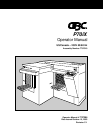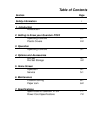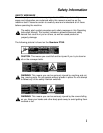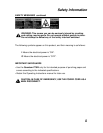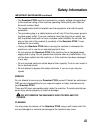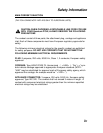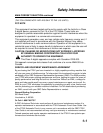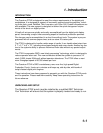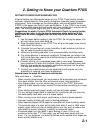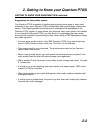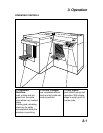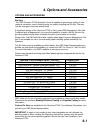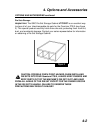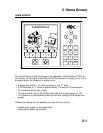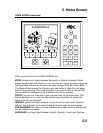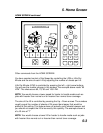
2. Getting to Know your Quantum P70iX
2-1
GETTING TO KNOW YOUR QUANTUM P70iX
External factors can affect performance of your P70iX. These factors include
customer requirements for hole quality, throughput materials (paper/transparen-
cies/covers), toner coverage on the printed page, and environmental factors.
STATIC in the paper can result in poor performance. If your P70iX runs a fresh
ream of clean white paper but has trouble with your printed job, it may be due to
static. The following tips might help you to correct this problem.
Suggestions for static: If you’re P70iX Automatic Punch is having trouble
running certain jobs, it may be due to excessive static build-up in the
paper. Here are some suggestions that may help to minimize the static
effect.
1. Fan the paper before loading it into the P70iX. Do not jog the paper; this
will only cause more static build-up.
2. Slow the speed down on the P70iX. This will give the paper more time to
settle down into the die.
3. Consider the purchase of a room humidifier to add moisture into the air.
Dry air helps to produce more static.
4. Move your punching operation to an environmentally controlled room.
5. Pay close attention to seasonal conditions. Procedures you follow in the
hot humid days may need to be modified during dry winter months when
static is most common.
6. Consider storing your unwrapped paper jobs in very large Tupperware
type containers to retain the moisture. Using these containers along with
humidor type products can actually reintroduce moisture into the paper
that was lost during the fusing process.
7. Contact your copier/printer service department and enquire as to the
possibility of lowering your fuser temperature.
General areas to watch for maximum satisfaction.
Tabs must have a _” shoulder.
• When running mixed stocks, you must ensure the dimensions are consistent.
One stock smaller than the other will prevent proper hole registration.
• Very slippery paper or cover stocks may not run in the P70iX. Test small
stacks at slower speeds and/or smaller lift sizes before committing to a large
job.
• Cover stocks mixed with paper usually run best at slower speeds.
• If a very straight output stack is important for a particular job, you may find
the stack quality best when run at a slower speed.
• When running cover stock alone, performance is best at slower speeds.
• Improper loading of stack will result in feeding problems.
• Some specialty papers (NCR paper for example) will show handling marks.
• The punched edge of a stack will be taller than when it went in. With some
papers, paper sizes and die set combinations; you may want to reduce the
input stack to prevent slumping, instability or excessive height.
• Excessive paper curl can result in poor feeding or jams. If curl is not
excessive (more than ?” 2” from edge) you will have best results with curl
down. For our purposes, curl down is defined as the outside front edges are
down and the middle is up.



